
..........................................................................................................................................................................................................
specialized crux elite cyclocross bike

the crux elite occupies second place in specialized's 2017 offering for the cyclocross fraternity, one step below the crux expert. my rationale in requesting this particular model for review pretty much centred around the fact that i felt i'd be particularly incapable of doing justice to anything with the word expert in the title. you know it to be true.
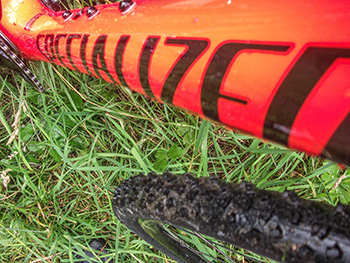
this particular model differs from the previous specialized 'cross bike i last had for review in several important ways, the most obvious being a carbon frame as opposed to shiny alloy. impressive as the aesthetics of the latter were, i can't deny a secret admiration for the combination of a very bright fluorescent red, matched to lime green edging at the dropouts. and that is where this bicycle once more differs from its alloy predecessor. instead of the usual dropouts that any of us would expect to hold our wheels in place, specialized have embraced modernity and opted for thru-axles both front and rear.

as a confirmed luddite, this presented one of those minor heart-stopping moments, but practically speaking, it's actually quite a slick means of fastening the wheels to the frame. rather than open alloy or carbon dropouts, each fork leg features a large diameter hole, the right-hand side of which, both front and rear, is threaded. it then becomes a simple matter of lining up the big hole in the hub with the two in the forks before inserting the thru-axle and doing what my neighbour always did with his quick-release; threading it in place. aside from any other benefit these may confer on the situation, it means there are no lawyer's lips with which to contend.
hurrah.
once these are securely in place, the lever is conveniently ratcheted, allowing it to be aligned with the fork leg, or whatever your particular proclivity demands. the front wheel is easy-peasy-lemon-squeezy, but the rear wheel is just a tad more of a faff, given the need to pull against the chain and derailleur tension. however, cyclocross is not a sport in which millisecond wheel changes are required, so all is well with the world.

in common with many a contemporary cyclocross machine, the crux elite features sram's single front chainring matched to an eleven-speed wide-range cassette at the rear. in this case, the groupset is sram rival, the lowest of the red/force/rival triumvirate. since the elite is also available as a frame only and thus subject to the particular requirements of its owner, the seat tube still features a braze-on bracket for a front gear mech along with internal routing for the associated cable.
the internal routing is aided and abetted by pre-fitted plastic tubes, prevented from disappearing inside by means of little bits of masking tape attached to each end. once the rear mech is cabled up (not as obvious at the mech as i'd thought), this can either be left in place, or removed. routing under the press-fit bottom bracket is simplicity itself before being protected by a bolt-on carbon plate. faff was the word furthest from my mind.

while we're on the subject of cables, the crux arrived with both hydraulic lines in place, the rear routed inside the curved carbon top tube and in a very welcome move, the front hydraulic line runs down the inside of the left fork leg. i say welcome, because the previous version gave me minor cause for concern as to how to properly route the hydraulic line to the front caliper; in front of the fork leg or behind or a bit of both. the rotors differed from the previous setup in that they are held on the hub by means of a lockring rather than a slew of separate bolts. the wheels are an impressive pair of dt swiss r460, a stylish and sober addition to the bicycle's fluorescent magnificence (gloss rocket red and monster green, as it happens)
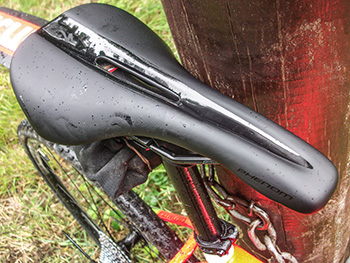
fluorescent paint has an inherent tendency to fade in ultra-violet light, often resulting in a once sparkly bicycle becoming a less than attractive off-white. according to a hang-tag attached to the seatstays, this particular paint formulation is designed to degrade to what promises to be a particularly pleasant dark red. specialized deserve a few extra brownie points for thinking ahead.
up front, the integral headset grows from 1.125 at the top to 1.375 at the bottom where it meets that rather sturdy looking fork. bars and stem are both badged as in-house components, the stem featuring a seven degree rise and stretching to a very modest 100mm. the bars are wrapped in a gel tape and are home to a right-hand lever that takes care of gear-shifting duties by way of sram's tried and tested double-tap inner flip lever. with no front mech, the left lever has only need of containing some hydraulic fluid for the rear disc caliper as well as a lever to make it work.
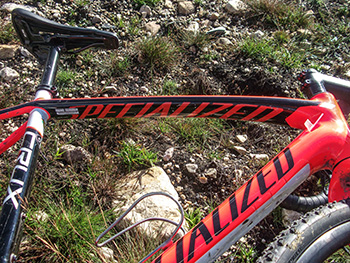
the black alloy rival bb30 x-sync chainset has a single 40 tooth chainring driving the chain through an 11-32t eleven-speed cassette. the tyres are a vast improvement over those fitted to the last crux to visit the hebrides. once more, they're from the specialized wardrobe with a squarish profile and plenty of mud-releasing space between the small knobbly bits. according to the sidewall legend, these are 700x33c terra pro 2bliss ready, whatever that is intended to indicate.
for a bicycle sporting a big, thick, chunky downtube, it was a pleasant suprise to find the alloy seatpost to be of the one-time industry standard 27.2mm, topped by a specialized phenom comp saddle with cro-mo rails and the almost ubiquitous slot in the centre. as ever, the bicycle arrived without pedals, so i fitted my own crank bros. candy #7.
going for a ride

at the risk of sounding just a tad over the top, this is quite possibly the best bicycle i have ever ridden. not just the finest 'cross bike, but the finest bike. it's a bicycle with soul, from it's simply red curved top tube (which has the word specialized writ large underneath) to its al green fork ends, the crux elite was as funky as it gets. though i cyclocrossed my little legs off in all manner of terrain, i simply swapped the tyres for a pair of challenge strada bianche 33mm road tyres and took part in this year's ride of the falling rain. if the government ever instigates bicycle rationing and limits us to a single bike, this is the one to have.

taking it at its word, i frequented the undergrowth in nearby bridgend woods, where mud, grass, rock and gravel scarcely gave it cause for concern. i'm not really enough of an engineer to unequivocally place its chuckability at the door of those front and rear thru-axles, but it would be naive to think they've not got something to do with it. i have long trailed the directional qualities of colnago bicycles to be the bar by which most others are judged; this was/is every bit as good, if not better.
the final part of my usual scrabble around the woods involves my following the sheep tracks down uiskentuie dunes before depositing myself unceremoniously on a seat at debbie's. this almost always has involved a certain amount of lateral toing-and-froing off the grassy edges, but in the case of the crux elite, it was like riding a tram rail from beginning to end. even the sheep failed to scare it from its line.

just to provide the ultimate local trial for such a bright bicycle, i scrabbled my way along the gravel road leading to islay's sole wind turbine, a road additionally used for peat extraction and all the detritus which that involves. as if that were scarcely sufficient, i took a trip through ballygrant woods along its lengthy loose gravel track before switching onto the walkway installed by dunlossit estate some years ago to aid traffic-free walking from caol ila to ballygrant.
though the surface of the latter is ostensibly gravel, in point of fact, these are demonstrably large chunks of gravel and really not the sort of stuff you'd enjoy walking on. no doubt that explains the fact that i met not a single walker from end to end, despite it being a saturday morning. no matter the surface material or quality, the specilized cross tyres slipped not once, while the rival's gearchanging abilities are worth a round of applause all of their own.
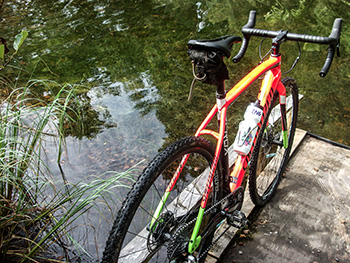
saddles rarely give my posterior too much discomfort no matter the brand stamped underneath. the specialized phenom was no different, offering a fine topping to accompany the rest of the bicycle. i'm still of the opinion that disc brakes fall into the category of a solution looking for a problem, a bit like electronic gear systems, but it would be hard to deny that the sram rival calipers and rotors offered handfuls of braking power even in the hands of the occasionally inept. there was a smidgeon of screeching when wet, but generally speaking they were as silent as they were strong.
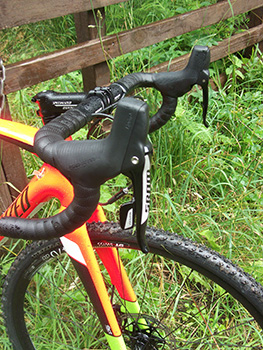
but leaving all the technicalities aside, i must once more return to my contention that the crux elite has soul. whether on-road or offroad, it was accompanied by an ear-to-ear smile, demonstrating the admirable trait of always wanting to go faster at whatever speed i happened to be cruising at the time. fitted with road tyres, albeit 33mm wide, it was comfort personified with seemingly little to slow it down when in a peloton of bona-fide road bikes. it's not the lightest on the market; that's something that might conceivably be remedied with the crux expert, but it's hardly a huge burden when the cross course takes a walk in the park, either recreationally or competitivel.
additionally, though sram offer force and red groupsets above that of rival, specialized have chosen well in fitting rival, a groupset that really did have me wondering why i'd need either of its big brothers.
if you have room for only one really, really good bicycle in your life as well as a propensity to enjoy tarmac and gravel in equal measures, might i respectfully suggest that the crux elite should be occupying the top spot on your shopping list. if you intend racing, the switching of tyres ought to make it just ginger peachy for both competition and road training. at a retail price of £2300 this is music for the soul.
monday 29 august 2016
 ..........................................................................................................................................................................................................
..........................................................................................................................................................................................................i'm right, you're wrong

we were pretty much all fooled into a false sense of security and it's all the mountain bike's fault. though the wholesale advent of carbon fibre has probably rendered my argument null and void, when i first became acquainted with the bicycle, via a muddy fox courier, stems and headsets were precisely the same for offroad as for road. what we would nowadays refer to as the quill stem had the ability to be not only functional but, in the hands of the masters, more than aesthetically pleasing.
a single allen bolt at the top allowed the intrepid cyclist to raise or lower the handlebars as desired. the bolt, when tightened, pulled a wedge upwards against the angled lower portion of the stem, thus jamming the whole enchilada against the inner face of the steerer, whether aluminium or steel. in principle, it's not inconceivable that this system could have been modified to carry out the same function inside a steerer of carbon fibre construction. but the headsets that accompanied such technology were threaded, a much harder ask when it comes to carbon.
however, what allegedly created a pressing need for change, was the salient fact that any play in the headset required two substantial spanners to adjust. apparently those bounding about in the undergrowth were reticent to carry such large tools, yet frequently experienced a loosening of the headset in the process of being gnarly. thus, the aheadset was born; any untoward movement could be sorted by tightening the stem downward upon the top headset cup, requiring only a five or six millimetre allen wrench.

apparently mountain bikers were ok with that.
the downside to all this headset/stem centred development was the apparent necessity to migrate everything towards the road despite a completely different set of circumstances. even allowing for the ingress of the aheadset to the road bike, when was the last time you had to adjust your headset on the sunday ride?
precisely.
modern day stems bear no comparison with those quill versions formerly produced by cinelli et al. but of course the ever increasing diameter of the headtube, again filtering down from the mountain bike and a period of wholesale use of aluminium as a frame material, meant a concomitant enlarging of the headset, before pragmatism intervened and popped the bearings inside and avoiding the average bicycle appearing to have a dinner plate sticking out from under the now less than pleasing and completely non-height adjustable stem.
i admit i'm on slightly shakier ground when it comes to the introduction of bottom brackets on which the bearing cups escaped to the outboard edge of the bb shell. i've no real idea whether that hit mountain bikes and road bikes simultaneously, but all is academic now that the threaded shell has gone the way of the dodo, to be replaced with the arguably superior press-fit bearing. the wholesale adoption of this standard by the world's frame manufacturers, has made any protests from the great unwashed (me) entirely moot.

or has it?
though i have been seemingly happy to place the blame for each and every iniquity at the door of the hapless mountain biker, the most recent development is one that i sincerely hope inflicts itself upon each and every road and 'cross bike; the sooner the better.
it seems that the offroad chaps have re-discovered the 73mm threaded bottom bracket. in fact the intelligent fellows at santa cruz mountain bikes (and it may be worth my while pointing out that bike handling supremo danny macaskill rides santa cruz) never dispensed with this technology in the first place. their north american marketing manager, don palermini, figures it never cost them a single bike sale.
why should you be bothered? most folks climb aboard their state of the art carbon and simply pedal. fixing stuff when it doesn't work is the job of the local bike shop, so why should we worry? well, the press-fit bottom bracket has received more than its fair share of bad press (if you'll pardon the pun). they have garnered a reputation of loosening more often than truly desirable and, due to the inability of carbon fibre to be manufactured perfectly round, many a press-fit set of bearings complains loudly at each pedal stroke.

there does seem to be something of an admission that press-fit is a better choice where weight reduction is of major concern, but considering the modern-day ability to have a road bike wheel up way below the uci lower limit of 6.8kg, a few grams on the bottom bracket seems unlikely to give cause for concern. meanwhile, the good old threaded standard offers mechanical reliability combined with easy maintenance.
aside from santa cruz who have remained faithful throughout, specialized have reinstated threads in their 2017 enduro mountain bike and niner bikes have also fitted threads to one or two machines in their range. industry intelligence figures that others will likely follow, particularly on offroad bicycles that rely less on their all up weight for customer satisfaction. granted, colnago have bestowed a replaceable alloy adapter on the c60 to bypass the age-old problem of manufacturing carbon fibre as perfectly round, but a dram of ardbeg to the first road bike manufacturer to move back from press-fit to threaded.
thanks to mark rushton for alerting me to this promising devlopment.
sunday 28 august 2016
 ..........................................................................................................................................................................................................
..........................................................................................................................................................................................................good karma

in a change from my usual friday afternoon escapades, rather than play hooky from the office to indulge in extra-curricular velocipedinal activities, i was yesterday more gainfully employed. the sense of glee was, however, barely lessened by the need of a cycle ride to port charlotte, a village some seventeen kilometres distant. since the trip was of a business-like nature, thus demanding just a smidgeon of sartorial elegance, i opted for the taurus, meaning no need to change from daily attire. the addition of a casquette was all that was required.
the fly in the ointment at this time of year is the fulfilling of the annual prophecy that winter begins on the day following the annual agricultural show, an event that took place on august 11. though blue sky could be regularly viewed above, so could thick black cloud, the portent of heavy showers that could be frequently seen just south of portnahaven, but edging ever closer.
the trip from bridgend to port charlotte was into a headwind, a factor made all the more iniquitous by the choice of only three-speeds on the rear hub; never the right gear at the right time. that wind also made it undesirable to don any kind of waterproof, for the ambient temperature was most amenable and i'd have been every bit as wet inside as out. but though i might be daft, i'm not stupid, so i'd placed a foldaway waterproof on the rear rack.

i should also point out that my timing had been well-judged to allow for a soya cappuccino en-route while still making the appointment on time.
business of the day over and done with, it was time to head homeward with the benefit of a tail wind and a sturmey-archer third gear to speed my inevitable return. though those of you in urban and city regions may come across the occasional traffic snarl-up or an agglomeration of pedestrians on the way home, the grassy roadside on the outskirts of bruichladdich is most often frequented by a flock of munching sheep. and it may surprise you to know that said munching can often be louder than you'd think. therefore a slight noise over and above my heavy breathing assumed no particular importance at the time.
that is until a bicycle front wheel nosed alongside as i ascended the short climb at blackrock. the gent sited just aft of that wheel enquired whether i might have lost a waterproof as i left bruichladdich village? he was not wrong, you know. no longer bungee'd to the rear rack was the vulpine disc waterproof that he proceeded to lift from his single pannier. i thanked him profusely and he headed north at a rate considerably in excess of my own.
as my daughter once said many years ago "cyclists are really nice people." i do hope the fellow is enjoying the fruits of his good karma.
saturday 27 august 2016
 ..........................................................................................................................................................................................................
..........................................................................................................................................................................................................the way we were

in the good old days of yore, the tension rods on the average and not so average bass drum featured nice little handles with which to effect tensioning of front and rear heads. in the contemporary era, however, these effective little devices, more correctly referred to as t-rods, have been all but replaced by standard drum-key bolts. as one not afraid to come across as a total luddite, i have replaced each and every tension bolt on both my bass drums with t-rods, not only because i find it a tad easier to tune the drum(s) on the fly, but because i think it looks one heck of a lot better.
if it was good enough for buddy, gene, max, elvin and art, then it's more than good enough for me.

it's very hard to figure out just why these t-rods were replaced in the first place. there was nothing wrong with them in terms of function and for those who suddenly found themselves bereft of a nearby drum key, they were something of a godsend. i'm more than willing to accept that the average audience at all but a jazz piano trio gig would be hard-pushed to notice any perceived deficiencies in bass drum tuning, but that's not to say an attuned drummist might find themselves on the wrong end of an irritation curve, one that might easily be solved by the clockwise twist of a camco style t-rod.
cycling componentry, in its time, has suffered its own fair share of similar iniquities. i need only point the finger at the ubiquitous quick-release lever. this efficacious device - now threatened with imminent demise by the arguably more effective thru-axle - in the hands of tullio campagnolo had an ergonomic that, in my humble opinion, has yet to be bettered. but as with many an item of functional utility, someone always figures their deigned 'improvement' to be unquestionably better. sadly, that is more often than not, rarely the case.

but i recall my first mountain bike in the late 1980s, featuring handlebars festooned with a pair of suntour (remember them?) thumbshifters. for those of us more used to ten-speed road bicycles with down-tube levers, these were something of a revelation, offering as they did, the opportunity to click up and down those eighteen gears without the more usual faffing to engage the appropriate sprocket (front or rear). for thanks to the ministrations of shimano, copied by both suntour and campagnolo, clicking was now the in thing; indexed gears were here to stay.
or were they?
you see, atop each right hand thumbshifter (front gear shifting would have to wait a few years for indexing), was a metal half-ring that allowed the user, for reasons of retro love or practicality, to switch from indexing to friction-shifting. (i do also recall a similar function available on campagnolo's road downtube levers.) at the time, we were at the cutting edge of gear shifting, one that may have hidden treasures such as an inability to respond correctly to each click, either through maladjustment or, as happened to yours truly, a seriously clouted rear mech that subsequently forgot about indexing altogether.

of course, for the relatively young, brought up in the days of electronic shifting, or the slightly less so who have no idea whatsoever as to what i mean when referring to friction-shifting, the very concept may seem positively laughable. but to my mind it was a convenient fallback; perhaps rarely used, but there nonetheless. i am insufficiently well-versed in the intricacies of lever design to know whether a legacy friction shift is even possible these days. maybe those ramps cut into the cassette sprockets would not play happily with man-made gear shifts.
with sram having equipped their sponsored riders with wireless gear changing, the almost inevitable descent into hydraulic disc brakes on road bikes, accompanied by the aforementioned thru-axles, adoption of cable-less gear systems by the other two cannot be far behind. when that happens, the carbon down tube will likely become whole once more, with no need for internal routing channels.
at which point, there will be a spike in my web stats, as you all rush to read of the days when gear-changing could still be under your own (occasionally misjudged) hamfistedness.
you're welcome.
friday 26 august 2016
 ..........................................................................................................................................................................................................
..........................................................................................................................................................................................................canned heat

just the other day, i received communication from british cycling reminding me that the annual subscription for my silver senior membership would be removed from my bank account on or around the beginning of next month. following renewal, i will doubtless receive a further communication including a membership card to which i can add a photograph prior to encapsulating it within the convenient little plastic envelope supplied. from what i recall, this can also ultimately serve as my competition licence, should the competitive urge suddenly and unexpectedly overtake me.
rest assured, this will never happen.
so, you may ask, why have i bothered to join the governing body of the uk branch of the sport in the first place? to be honest, this was as a result of an article many years ago in the guardian newspaper by the inimitable matt seaton (a gent now installed at the new york times). in this, matt pointed out that the majority of britain's cyclists are riding around on public roads unfettered by any form of insurance. despite motor insurance being compulsory, and without which drivers risk prosecution, cyclists are free to take to the roads, obviously not without risk, but quite possibly unable to recompense any motorist or pedestrian should they unfortunately have an incident with either.
i figure that at least third-party insurance ought to be compulsory for each and every adult cyclist of eighteen years and over. not as a means of punishment or shackle upon the freedom of the cyclist, but as protection for both them and any third party into which they may come in contact. let's face it an annual levy of £42 is hardly an onerous amount to offer piece of mind to the tune of up to £10 million. but if i have no intention of competing at any time in my career, why did i not simply join what was formerly known as the cyclists' touring club (now re-named cycling uk, though i have no idea why)? the third party insurance that comes with adult membership offers the same potential cover, though admittedly at a cost of £1 more.
i cannot deny that my reasons had mostly to do with the somewhat sedentary image portrayed by the (then) ctc, one that i note has not improved with the website offered by cycling uk. british cycling's membership has topped 125,000, based, i would imagine, on a higher profile within the cycling community and association with olympic track success, despite the majority of its members being as non-competitive as yours truly.
membership of cycling uk, as mentioned in a recent washingmachinepost article, is a more conservative 67,000, though still a substantial number and one that could offer a modicum of lobbying power should push ever come to shove. but what if we added the two together? 125,000 plus 67,000 gets us demonstrably close to 200,000 at which point, as clearly stated by d:ream 'things can only get better.'
realistically, how hard could it be for british cycling president bob howden to get together with cycling uk's chairman david cox over a cappuccino and form a pact to benefit each and every member cyclist in the uk? why do we need two independent bodies in the first place? after all, even the folks that can break world and olympic records cycle to the coffee shop at weekends.
all those in favour...
thursday 25 august 2016
 ..........................................................................................................................................................................................................
..........................................................................................................................................................................................................ridelo

comedian bill murray tweeted recently that, if charging our mobile devices relied on personal effort, the western world would be the fittest on the planet. it's a hard contention to deny. the daughter of a work colleague often spends half-an-hour or so in the office most mornings, prior to commencing her own job in neighbouring premises. on the majority of these occasions, the first act on entering the building is to plug-in her iphone charger before staring intently at its screen for the remaining twenty-five minutes or so.
though i am now well past wondering what on earth is so cotton-picking important in a teenager's world that needs that phone to be an almost permanent accoutrement whenever possible, there's no denying that these devices plough through a charged battery like wildebeest through a china shop. hinkley point notwithstanding, the world's increasing dependency on digital devices, all of which demand the availability of endless sources of power, quite likely means that our energy demands will increase, rather than decrease.

while trying not to be smug as still only one of two individuals in the world without a mobile phone, i do like to have my ipod permanently charged, along with the sony bluetooth speaker unit that allows me to enjoy the musical musings of art tatum, lionel hampton and buddy rich whenever and wherever. granted, neither device requires anything like that of your average smartphone, but still...
as keen, if not totally obsessive velocipedinists, we may occasionally be guilty of protesting too much and too often about our environmental credibility. but how many of us have the garmin on charge each saturday evening, ready and waiting for the sunday morning ride? and should you wish to partake of the inevitable bluetooth connectivity of the modern-day gps device, we're immediately back to those smartphone chargers once again.
to quote the slogan featured on the front of an n + one t-shirt "if you see me collapse, pause my strava", but what if a lack of power meant at least one of those devices paused itself before the ride ended? i know more than just a single individual for whom the gps record accompanying the sunday ride is every bit as important as the pedalling itself. possibly even more so than the coffee at the end, though admittedly that might be stretching credibility a shade too far. surely if messrs wiggins and froome base their entire race strategies on a consistent power output, at least a portion of the latter could be re-directed towards any nearby attached digital stuff?

in truth, i'm surprised more fuss has not been paid to such a concept. that's not to say it is currently impossible to charge devices from the bicycle at present; on my visit to shand cycles a year or so ago, the stoater on the workstand featured a front hub offering a usb connection at the stem. but now adrián páles and filip tomáska have apparently created a kinetic phone charging device, one that is frictionless, thus avoiding the drag that can affect many a dynamo. according to the two slovakian entrepreneurs, their invention weighs a mere 70 grammes and charges every bit as fast as the charger when plugged into the mains electricity.
so far, their website offers a simple animation demonstrating the whys and wherefores; i have seen no sign of a working model. however, so far as i can ascertain, signing up for more info prior to a production schedule does not relieve your paypal account of your hard-earned, though i'm sure that optional stage will come later.
if this sounds like the very development for which your iphone has been impatiently waiting, type your e-mail address into their welcoming website and adrián and filip will keep you enlightened.
wednesday 24 august 2016
 ..........................................................................................................................................................................................................
..........................................................................................................................................................................................................a game of two halves
i have no great wish to portray myself as any more of a killjoy than is already the case, but certain stark realities of the recent rio olympic games, particularly with relevance to the cycling activities of team gb, have struck me as more than just slightly iniquitous. the relvelation in last week's comic that the gb track cycling team's budget simply for equipment was greatly in excess of the budget for the entire usa track cycling team including personnel was really only the start. the fact that the lottery funding directed at cycling is in excess of £32 million and bettered only by rowing's £32.5 million (nope, me neither) strikes me as very much at odds with the ultimate endgame of competing solely for medals.
bbc radio four's today programme pointed out yesterday morning that all those medals won by the entire british olympic team, taking the country to second place overall, came at an average cost of £4.1 million each over the past four years. with no disrespect to the competitors themselves who did pretty much exactly as they were directed, i'm sure there must be more deserving ways of spending all those millions.
however, while we all cheered to new levels of hoarseness during the track events, and smiled knowingly during the less successful road events, there is serious disparity in the ranks. it seems that for team gb, the word cycling is no longer an all-encompassing notion. while each and every cycling discipline involves pedalling as fast as possible, those at management level have not offered a level playing field for all the competitors entitled to wear that horrendous looking tracksuit.
scottish cycling journalist, kenny pryde, published the following article about britain's only cross country mountain bike competitor on his own blog biscuit tin media. for scotland's grant ferguson the pre-olympic run-up was considerably more trying than was the case for wiggins, trott, skinner and kenny et al. it doesn't paint a pretty picture.
Grant Ferguson raced the Rio Olympic mountain bike event and finished a battling 17th. It was a performance that went mostly unnoticed...

With British riders claiming six gold, four silver and two bronze medals at the Rio Olympics, mountain biker Grant Ferguson's 17th place in the men's cross-country (XC) event might look underwhelming. Ferguson finished just over five minutes down on the winner, reigning world XC champion Nino Schurter, but as an athletic performance it deserves huge credit. Ferguson's road to Rio was far from ideal too, adding more sheen than that result might suggest.
The 22-year-old from Peebles in the Scottish borders fought a tough campaign to try to qualify Great Britain for a place in the Rio event. He fought to gain points on his own, as no other GB riders raced consistently in the World Cup series where points for the Games allocation were awarded. From April, when the World Cup mtb XC season kicked off, in Cairns, Queensland, the Scot has been on the road looking for points. In between times, he raced on the road, at home and in European mountain bike events. Ferguson has actually been racing since February and, by any reckoning, should be knackered.
He is young and used to it though. He went to Cairns, in sub-tropical Queensland, a week before the opening World Cup race of the season - and his first ever in the Elite category rather than under-23 - he finished 17th then flew straight home and into the chilly five degree, wet Tour of Yorkshire, where he battled with the World Tour squads of Team Sky, BMC, Orica, Dimension Data, Katusha and Lotto-Jumbo amongst others. One weekend in a humid 30 degree mountain bike race and then - jet-lag be damned - less than a week later, battling World Tour pros on Yorkshire's brutally steep climbs.
"Yeah, the travelling can wreck you," admitted Ferguson, "plus the fact you are missing days on the bike. After Cairns, which was a tough race, I did a ride on the Monday, then it took me till Wednesday to get back to Britain, did a short road ride, then was on my way to Yorkshire. By the time I got to the Tour of Yorkshire in April I had already had 22 flights. It's not something that I'd want to do or normally do, but we've been racing to score points for Rio. So you are ruined from the race, then the travelling on top, then straight away preparing your bike and kit for another race the following weekend and you are nailed from that too." Unlike the national road team, there's nobody picking you up and sorting your schedule and transfers, with mechanics prepping your bike. "When you add it all up, it wears you out," confesses Ferguson.
So, Ferguson flew back to the UK from Cairns and went straight to the 2016 Tour of Yorkshire. "I had done minimal amounts of time on my road bike," confessed Ferguson, "I had raced at the Chorley Grand Prix in late March but..ah...then nothing," he laughs. Nothing to get used to racing in a pro road peloton. "Yeah, I was aware that it would be a bit of a challenge," he chuckles, "the first day in Yorkshire I felt like death; no way was I recovered from Cairns, I think I fell asleep in the bunch at one point, then I blew on the finishing circuit." Nevertheless, Ferguson finished the three-day race, one of only two riders in the GB team to do so.
"In the back of my mind I knew that even though I was going to come out of Yorkshire ruined, because there were World Cup races a few weeks later, I kept thinking that the race would stand me in good stead. It was important to get some good volume training in as well, because I had been tapering for Cairns," added Ferguson. "Mind you, that last stage was hard. 200k in the North York Moors with 12k of neutralised on top. I was actually climbing OK, but the wind...oh, that was something else and when it split in the crosswind and I had to ride myself back into the race by myself for a while. I caught up with the group that turned into the grupetto and I was swinging. I had 16 gels and so many cans of Coke!"
There you go, the hardest race in the British road calendar used as training by a 22 year-old mountain biker, with his eyes on trying to qualify GB for a slot in Rio. Two days later he had another two early morning no-frills flights, this time to Sweden for the European mtb championships. The search for points for Rio was non-stop - and they had to be scored by the end of May.

With only the top 23 nations guaranteed places on the start grid in Rio, Great Britain benefitted from a wild-card thanks to the non-appearance of all riders from other nations. With the top three riders from each nation contributing to the points tally and Ferguson, essentially, being GB's only counting rider, he was always facing an uphill battle. He could either travel to Russia, Greece and Serbia to try to score points in smaller races, or target the bigger points on offer in World Cup events. It wasn't an easy choice. While Nino Schurter and other big hitters could pick and chose their events, Ferguson was obliged to flog himself. And flog himself he did.
In early July, Great Britain was offered a slot for a single rider in the men's cross-country mountain bike race in Rio, relying, in the end, on an unused place from another qualified country. It's a state of affairs unthinkable in either Great Britain's track or road programmes and, of course, there was no place for any British women XC riders either.
While British Cycling has poured millions of pounds into track and road cycling, mountain biking is very much the Cinderalla sport in the UK, under-funded and unloved. Ferguson races on the World Cup circuit for his pro trade team, Brentjens-Superior - a Dutch and Czech outfit. For all that GB needed Ferguson to qualify the nation for a place in Rio, he was essentially flying the flag solo, supported mainly by Holland and the Czech Republic.
Furthermore, when you consider that, essentially, British Cycling was relying on Ferguson to score points, all those Team GB eggs were in his basket. Had Ferguson injured himself or fallen ill, there was no back-up strategy, there was no Plan B. In a country that has been been banging on triumphantly about its cyclists on road and track, priding itself on its planning and 'marginal gains' it appears that there is plenty room for not-so-marginal gains in mountain bike racing.
The post-Rio de-brief should be entertaining...
grateful thanks to kenny pryde for allowing me to re-print the above article, first published on biscuit tin media | ©kenny pryde 2016.
tuesday 23 august 2016
 ..........................................................................................................................................................................................................
..........................................................................................................................................................................................................